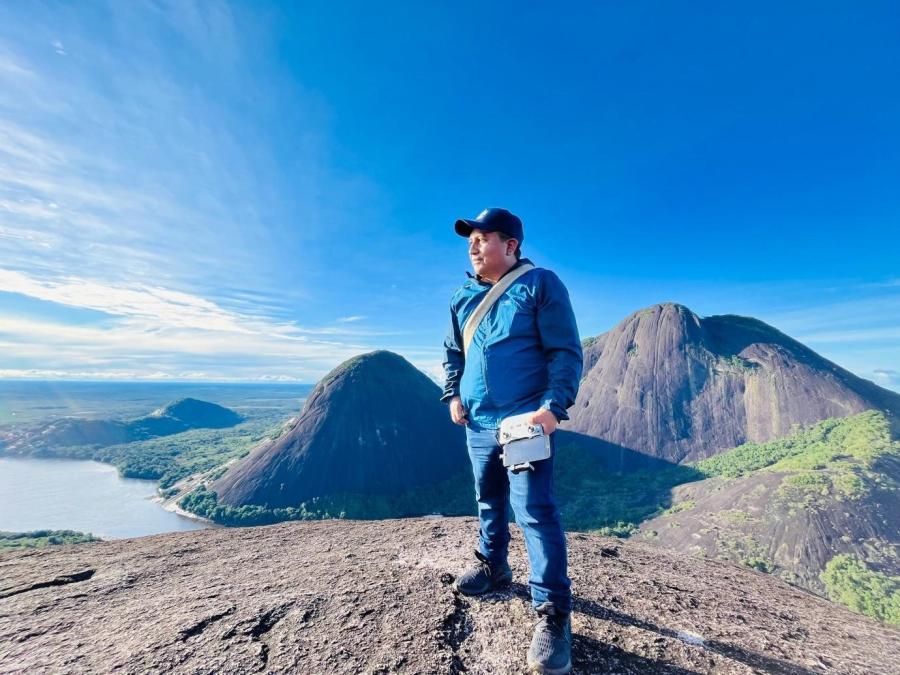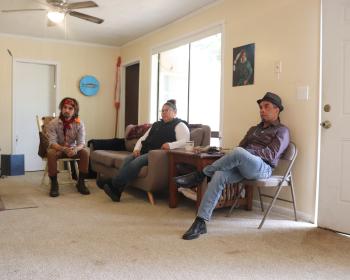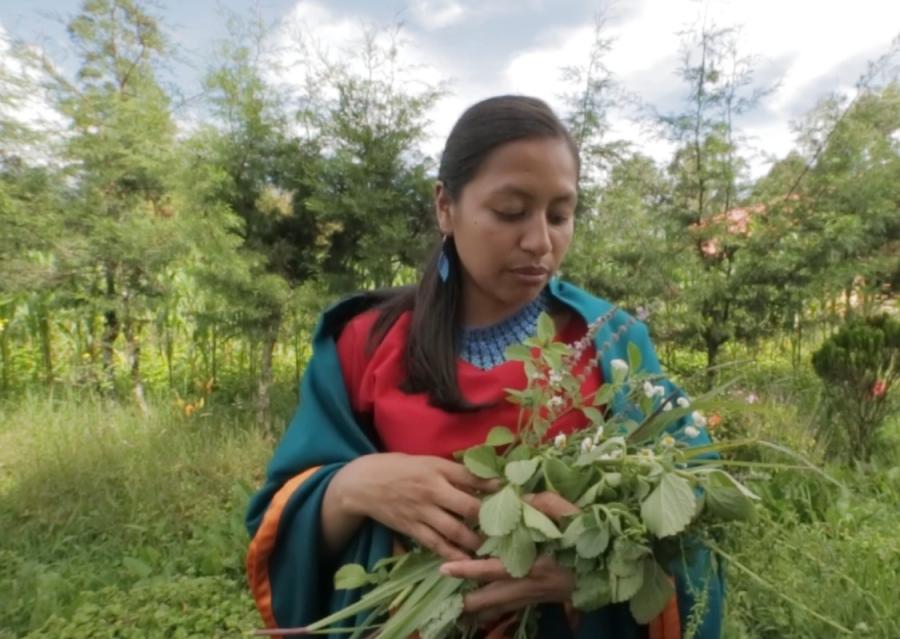Mamo Zäreymakú was one of the spiritual leaders (Mamos) of the Arhuaco people of northern Colombia. The Arhauco and three other related peoples—the Kogi, Arzario, and Kankuamo—live in an area encircled by what they call the Black Line. The line is a spiritual boundary that demarcates their traditional land and is punctuated by a series of sacred sites at which the Mamos make “payments” to the gods and maintain the balance of life on earth. Shortly before his death, Mamo Zäreymakú discussed his people’s beliefs with Jesús Ortiz, who published them in the book Universo Arhuaco. The text below is adapted from that conversation.
In the beginning of creation the mountain ranges were created: the hills of the Sierra Nevada de Santa Marta, which are sacred. To me, they are gods who face each other like houses in a town. The first thing to be engendered was the thought of the mountains, and then they came to have form. The first mountains to be born were the fathers of all: animals, peoples, plants, and waters. In them, the universe is embodied.
In the mountains, the different races were born. The Mamos saw that it was going to be difficult for all of us to live here, for at that time whites were reproducing very rapidly, and there was not going to be room for all in the Sierra. They appealed to Serankwa, Ñankwa, and Seukukuy, who are the creative forces of the world and who dwell here. Since we have to share the earth, the world was divided, and Serankwa began to create more lands for other peoples to live in beyond the Black Line, and made them heed the advice of the Mamos, who in unison directed them to go and settle in places outside our sacred territory.
The animals, birds, waters, Chundwas [snowy peaks], and all that we see were first born in the Sierra Nevada before they were born in other lands. Here, the food for daily life was born. Here are the father and mother of the forests, of humankind. Everything is embodied here in the sacred abode of the Sierra Nevada de Santa Marta. The lagoon is the female counterpart of the sacred mountain, and the original sites of them are four, embodied in the four peoples: Kogi, Arzario, Arhuaco, and Kankuamo, who are the pillars of the Sierra Nevada.
At the time of the origin of all things, all was pure thought. Food was not eaten as we do today, but nourishment derived from the spirit of food. Neither the yoburu [also called poporo, the gourd in which lime is kept] nor the lime and the áyu [coca leaf] were used. Nourishment came from the energy of thought, from the emanation of wisdom—pure thought—as we now inhale the air. Everything was mist. There was no sun, no moon, and the stars had not been born. Only the morning star existed, to tell us the beginning of the day.
After thousands of years of being merely thought, the poporo was born, and then the shells to make the lime, and the food, the plants, and the animals. At that time also, all the languages that are spoken in the world were imparted. The masters of illness, known as Maku Yantaná, were also born at that time. With the appearance of illnesses, the Mamos gathered to find a way to control them; and they appointed Bunkwarwa Badillo as the pagamento site [a sacred site where mamos make pagamentos, or payments, to the associated spirits], so that illnesses would not destroy all peoples.
Leaders were also born, and rulers and the cabildos [landowner councils] and the sheriffs. They are embodied in the mountains as well, and that is why they still exist, for that is the spirituality that is in the Sierra.
Then, Mamo Serankwa began to create the other continents, which were inhabited by people from other places. But all this was done in accordance with the Sierra Nevada, where the fathers and mothers of the continents, countries, and races are. In the Sierra are represented the sun, Bunkuakukuy; Duia Arukukuy, father of the sun; and Duia Aru Aviku, the mother of the sun. Yui Kinchukwa, the site were the sun was born, is represented in a stone, as well as Sey Kinchukwa, the flight taken by the sun to illuminate all and find his place in space. Timarwa and Timaka, father and mother of the moon, also have their dwelling in our sacred abode.
But even before the appearance of the sun and the moon, the Mamo was already offering his pagamentos in the mountains that represented them. For there were some who did not want the dawn to come, and the Mamo had been working spiritually for the rising of the sun. Although the sun gives us light and life, we all have to work spiritually together with the Mamo who makes the "pagamento" to keep the sun from overheating and disrupting the weather and the seasons.
What I do is interact with Nature, and that is why I dedicate myself to the study of ancient wisdom, and I do my best to preserve Nature. My father used to do the same work: to preserve the balance in Nature, to converse with her. He dealt with the spirituality of Makutama, site of the power to rule over the forces of Nature, and with the power of the Tani: dances, rites, ceremonial costumes, and feathers. This work took place in a particular month, when people began to dance for the birds, the rain, and several kinds of food. That is why it is necessary to revive those Tani.
With the arrival of the Capuchin mission in Nabusimake, they began to appoint both Native and mestizo inspectors. They inculcated in us the need to study their religion, and some of our brothers became frightened and fled to places like Donachui, Simonorwa, and Palomino, which were uninhabited at that time. The inspector, who was appointed by the friars and used different kinds of pressure, told us to take our children to the mission. That contributed to the dispersion of our community. From then on, all the wisdom that we treasured began to fade. Such was the case with our brothers, the Kankuamo, many of whom forgot their own culture and were nearly lost.
The missionaries at the orphanage and the government thought that we Arhuacos also had to vanish, and with it the idea entrusted to the Mamos to preserve the world, to maintain the balance of the world by means of rites of preservation. If all this vanished, calamities and punishments would occur, and not only the Arhuaco, the Kankuamo, the Kogi, and the Arzario who live within the Black Line would be the losers, but also the government and the cachacos [or non-Natives]. The whole world would lose, because the Sierra Nevada is the place of origin for all of Nature. And the Mamo has got to preserve it; he has to maintain the great power that we keep, to comply with the duty bestowed on us.
Therefore, it would be good that the government took some measures that would help us to preserve this sacred place, where every element of Nature has its power represented in particular deities or relics, which are the mothers. For example, consider the case of the Guatapurí and Fundación rivers, which have their sources in the Sierra. They had to go down to the sea but lacked the strength to do it, so the Mamos presented their relics before them, and they became stronger and gathered in one basin and reached the sea. This is why the pagamento sites exist: to allow the Mamo to speak his words in order to maintain and confer strength.
Some years ago there was a period of crisis that started with a hard drought that was beginning to kill the snowy peaks of the Sierra. I started studying and analyzing why the glaciers and the waters were drying up. I thought that some Kogi brothers had a lot of knowledge to preserve waters, and so I went to talk with them. They also knew how to increase the flow of water. They told me that we had to make a very hard pagamento in a region called San Antonio. I asked them to give me the power to revive the waters, and they did. Today we are experiencing the same situation, and if the pagamento is not offered we are in danger of running out of water.
I, as a Mamo, represent all living beings: all of Colombia, the government, the ministers, the world. I dedicate myself to the preservation of Nature; and if I died the balance would be affected. I am made out of a very hard kind of wood, so I can give support to all living beings within and outside of the Sierra. I care for millions and millions.
For more information on the Mamos and their efforts to reinforce and pass on their knowledge to younger generations, see the Elders Project at www.earthaction.org. To see a film of the Mamos making the circuit of the Black Line’s sacred sites, go to Cultural Survival’s website, www.cs.org. Special thanks to Rick Harlow for his help with this article.



